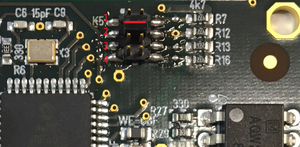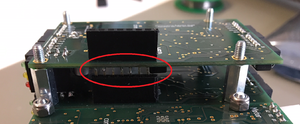Difference between revisions of "Additional DIO-Boards of the DCi Control Electronics"
From Wiki
| Line 1: | Line 1: | ||
The DCi Robot is shipped with one DIO module as standard. Should you require additional digital inputs and outputs, two additional DIO modules can be added. The hardware installation is simple, however, you need to get access to the underside of the robot. | The DCi Robot is shipped with one DIO module as standard. Should you require additional digital inputs and outputs, two additional DIO modules can be added. The hardware installation is simple, however, you need to get access to the underside of the robot. | ||
=Hardware installation= | =Hardware installation= | ||
| − | If there is only the standard DIO module installed, bridge the second pin-set of header K5 as shown in figure 1 using the jumper supplied with the module. (If there are already two DIO modules installed, bridge pin-pair 3 of K5.)[[file:DCi_second_DIOmodule.png|thumb|300px|To configure the second DIO module, bridge the second pin-pair of K5 as shown here.]] | + | If there is only the standard DIO module installed, bridge the second pin-set of header K5 as shown in figure 1 using the jumper supplied with the module. (If there are already two DIO modules installed, bridge pin-pair 3 of K5.)[[file:DCi_second_DIOmodule.png|thumb|300px|Figure 1: To configure the second DIO module, bridge the second pin-pair of K5 as shown here.]] |
<br clear=all> | <br clear=all> | ||
# Bring the robot into the referencing position, so that you can later turn it on its side. | # Bring the robot into the referencing position, so that you can later turn it on its side. | ||
| Line 7: | Line 7: | ||
# Turn the robot on its side. Once flipped one its side. You will see the electronics modules installed in the robot. | # Turn the robot on its side. Once flipped one its side. You will see the electronics modules installed in the robot. | ||
# Remove the four M3 hex nuts from one of the exposed modules and connect the four stand-off hex spacers supplied with the new DIO module. | # Remove the four M3 hex nuts from one of the exposed modules and connect the four stand-off hex spacers supplied with the new DIO module. | ||
| − | # Now carefully insert the module while making sure that the bus connector lines up and all pins get inserted into their socket counterparts(figure 2). [[file:DCi_additional_DIO_module_bus_connector.png|thumb| 300px|Install M3x12mm hex stand-offs and then the new module, making sure that the bus connector lines up and all pins are inserted into the sockets.]] | + | # Now carefully insert the module while making sure that the bus connector lines up and all pins get inserted into their socket counterparts(figure 2). [[file:DCi_additional_DIO_module_bus_connector.png|thumb| 300px|Figure 2:Install M3x12mm hex stand-offs and then the new module, making sure that the bus connector lines up and all pins are inserted into the sockets.]] |
Revision as of 11:23, 21 November 2018
The DCi Robot is shipped with one DIO module as standard. Should you require additional digital inputs and outputs, two additional DIO modules can be added. The hardware installation is simple, however, you need to get access to the underside of the robot.
Hardware installation
If there is only the standard DIO module installed, bridge the second pin-set of header K5 as shown in figure 1 using the jumper supplied with the module. (If there are already two DIO modules installed, bridge pin-pair 3 of K5.)
- Bring the robot into the referencing position, so that you can later turn it on its side.
- Turn off the robot and disconnect from power source.
- Turn the robot on its side. Once flipped one its side. You will see the electronics modules installed in the robot.
- Remove the four M3 hex nuts from one of the exposed modules and connect the four stand-off hex spacers supplied with the new DIO module.
- Now carefully insert the module while making sure that the bus connector lines up and all pins get inserted into their socket counterparts(figure 2).

